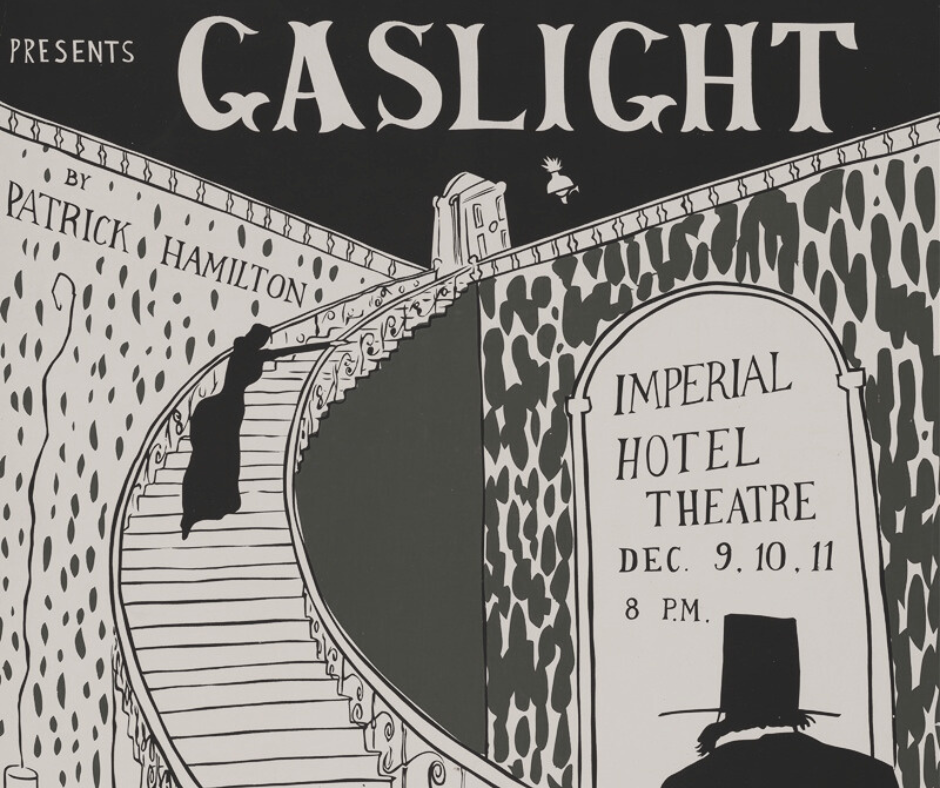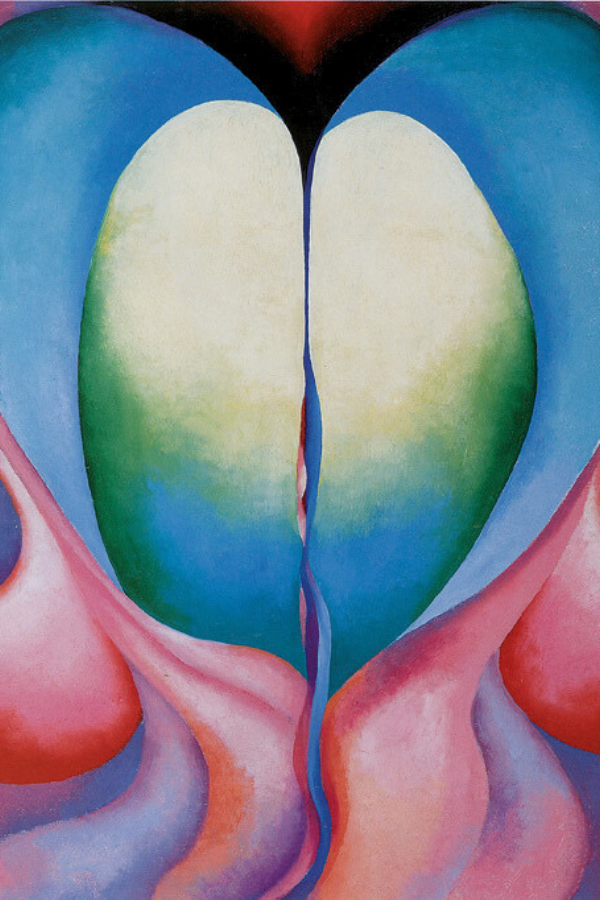
Famous Blue Paintings From Monet to Klee to Picasso
Summary
Often rich with symbolic meaning, blue evokes tranquility, introspection, and spirituality, and explores themes such as the vastness of the sky and sea, the melancholy of human existence, and the infinite realms of imagination. This collection examines famous blue paintings, showcasing how artists have harnessed the power of blue to create some of the most memorable and impactful pieces in art history.
Reflection Questions
- How does the use of blue in a particular piece of art affect your emotional response to it?
- Can you think of other cultural or historical contexts where blue holds significant meaning?
- How might an artist use different shades of blue to convey varying emotions or themes?
Journal Prompt
- Reflect on a piece of art where blue is the dominant color. How does the color influence your perception of the piece?
- Consider a time when you felt a strong emotion associated with blue. Write about that experience and how it aligns with the meanings discussed.
- Imagine you are an artist planning a new piece. How would you use blue to convey a specific message or feeling?
Blue is a color of exceptional depth and versatility. From the serene waterscapes of Claude Monet to the emotionally charged works of Pablo Picasso and the abstract explorations of Paul Klee, blue has been used to convey a wide range of emotions and ideas. This color—rich with symbolic meaning—often evokes tranquility, introspection, and spirituality. It has been used to explore themes as diverse as the vastness of the sky and sea, the melancholy of human existence, and the infinite realms of imagination. In this collection of famous blue paintings, we consider the works of artists who have harnessed the power of blue to create some of the most memorable and impactful pieces in art history.
What Does the Color Blue Signify in Fine Art?

Blue is a color rich with symbolism and meaning in art, carrying various connotations that can shift depending on the cultural and historical context. For example, blue is often linked to the sky and the sea, evoking a sense of peace, calm, and serenity. Artists use blue to create a tranquil atmosphere or to represent a state of inner peace.
Blue is also commonly associated with feelings of sadness or melancholy. This association is evident in phrases like “feeling blue” and is often depicted in art to convey emotional depth and introspection. In some cultures, blue is associated with mourning and death. For instance, in traditional Chinese culture, blue is a color of mourning, similar to how black is used in Western cultures.
In many cultures, blue holds spiritual significance beyond mere human feelings. For example, in Christian art, the Virgin Mary is often painted wearing robes of a blue color, symbolizing purity, divinity, and heavenly grace. Historically, blue dyes were rare and expensive, making blue a symbol of wealth and status. In many cultures, blue is associated with royalty and power.
In Western art, blue is frequently used to symbolize trustworthiness, loyalty, and integrity. This is why blue is a popular color in corporate branding and is used in portraits to convey these qualities in the subject. Alternatively, cool blue tones can create a sense of distance or detachment in a composition. This can be used to convey isolation or to highlight contrasts with warmer colors in a piece.
Last but not least, the vastness of the sky and the depths of the ocean give blue a sense of boundlessness and infinity. Artists use blue to evoke a sense of wonder, imagination, and limitless possibilities. French artist Yves Klein used his International Klein Blue (IKB) to explore ideas of the infinite and the immaterial.
18 Famous Blue Paintings Inspired by Sadness, the Sky, the Sea, Spirituality, and So Much More
Blue Cliff by Nicholas Roerich (Russian, 1874-1947)
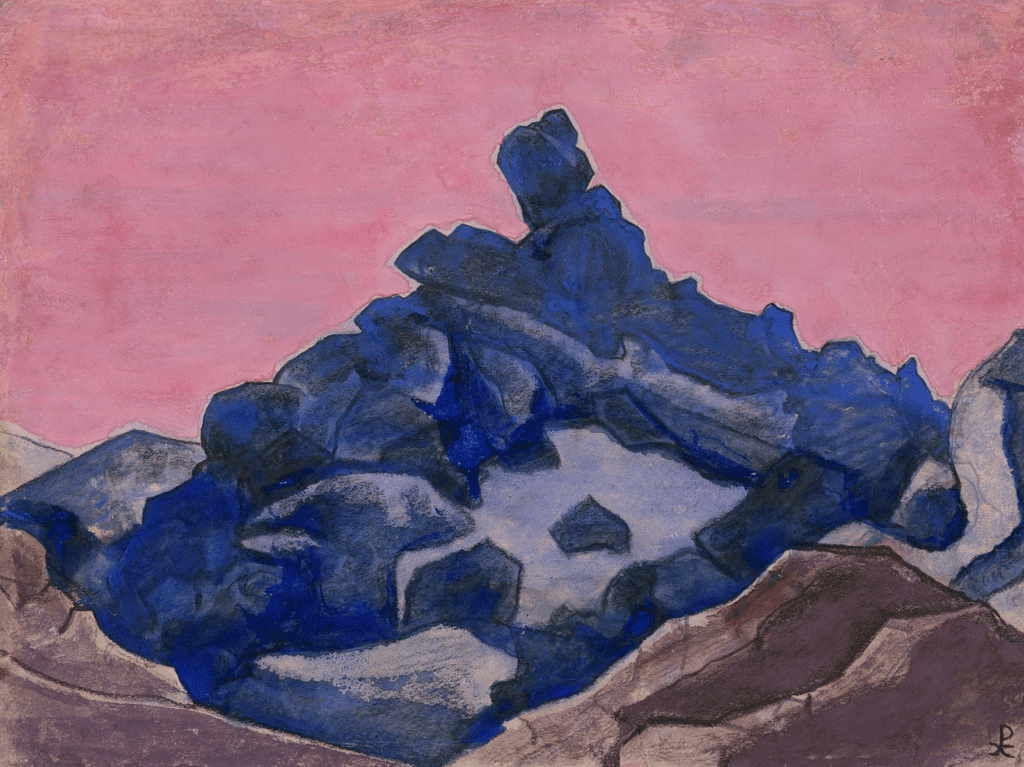
Nicholas Roerich’s painting “Blue Cliff” is a striking testament to his profound connection with nature and his ability to evoke a sense of mysticism through color and form. Nicholas Roerich, a Russian painter, is well-known for his mystical landscapes and his deep interest in spirituality and Eastern philosophies. His works often feature dramatic natural scenes infused with a sense of tranquility and spirituality, utilizing color to evoke specific atmospheres and emotional responses.
“Blue Cliff,” like much of his artwork, uses the color blue to create a serene, contemplative, and somewhat mystical atmosphere. The dramatic portrayal of cliffs or mountains is a recurring theme in Roerich’s work, symbolizing both the majesty of nature and spiritual aspiration. His meticulous use of blue in various shades enhances the ethereal quality of the scene, inviting viewers to engage with the painting on a deeper, more introspective level.
Abstraction (the Blue Mountain) (1912) by Christian Rohlfs (German, 1849-1938)

Christian Rohlfs’ “Abstraction (the Blue Mountain)” (1912) is a vibrant and dynamic example of early 20th-century expressionism. The painting features a striking depiction of a mountain rendered in bold, abstract forms and intense colors, with blue dominating the composition. Rohlfs employs thick, expressive brushstrokes and a vivid palette to convey the raw energy and emotional intensity of the natural landscape. The blue mountain stands out against contrasting hues, creating a sense of depth and movement.
This abstract representation transcends a literal interpretation of the landscape, inviting viewers to experience the emotional and spiritual essence of the scene. Rohlfs’ innovative approach to color and form highlights his significant contribution to the development of modern art, where the emphasis shifts from realistic depiction to the expression of inner experiences and emotions. “Abstraction (the Blue Mountain)” exemplifies Rohlfs’ mastery in blending abstraction with emotional depth, making it a powerful piece that captures the transformative energy of the natural world.
A Duchess (The Blue Dress) (c. 1866) by Alfred Stevens (Belgian, 1817 – 1875)

Alfred Stevens’ “A Duchess (The Blue Dress)” (c. 1866) is a refined and elegant portrayal of a woman dressed in a striking blue gown. Stevens, known for his exquisite attention to detail and the luxurious depiction of contemporary fashion, captures the opulence and grace of the duchess through his meticulous brushwork and rich color palette.
The blue dress, with its intricate folds and delicate lace, draws the viewer’s eye, emphasizing the sophistication and status of the subject. The painting’s composition and the subject’s poised demeanor reflect the genteel society of the time, while the blue dress adds a sense of regality and calm to the overall scene.
Stevens’ ability to render textures and fabrics with such realism highlights his technical skill and his keen observation of the nuances of light and shadow. “A Duchess (The Blue Dress)” is a testament to Stevens’ mastery in combining portraiture with the fashion and elegance of the 19th century, creating a timeless representation of beauty and refinement.
Nocturne: Blue and Silver–Bognor (1871-1876) by James Abbott McNeill Whistler (American, 1834-1903)
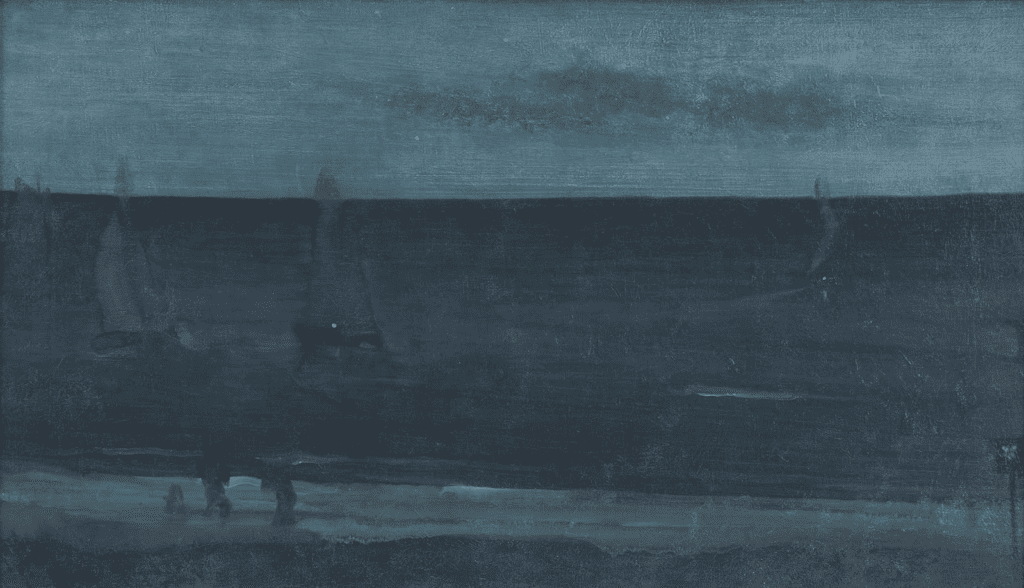
James Abbott McNeill Whistler’s “Nocturne: Blue and Silver – Bognor” (1871-1876) exemplifies his pioneering approach to painting, focusing on mood and atmosphere rather than detailed representation. This artwork is part of Whistler’s series of “Nocturnes,” which capture the subtle beauty of nighttime scenes through a harmonious interplay of color and light. In this painting, Whistler employs a limited palette of blues and silvers to evoke the serene and tranquil ambiance of the seaside town of Bognor at dusk.
The composition is characterized by its minimalist style and soft, diffuse edges, which create a dreamlike quality. The gentle gradations of blue suggest the fading light of evening, while the touches of silver hint at reflections on the water’s surface and distant lights. Whistler’s use of thin, almost transparent layers of paint enhances the ethereal effect, inviting viewers to experience the quiet, contemplative beauty of the scene.
Sunlight in the Blue Room (1891) by Anna Ancher (Danish, 1859 – 1935)
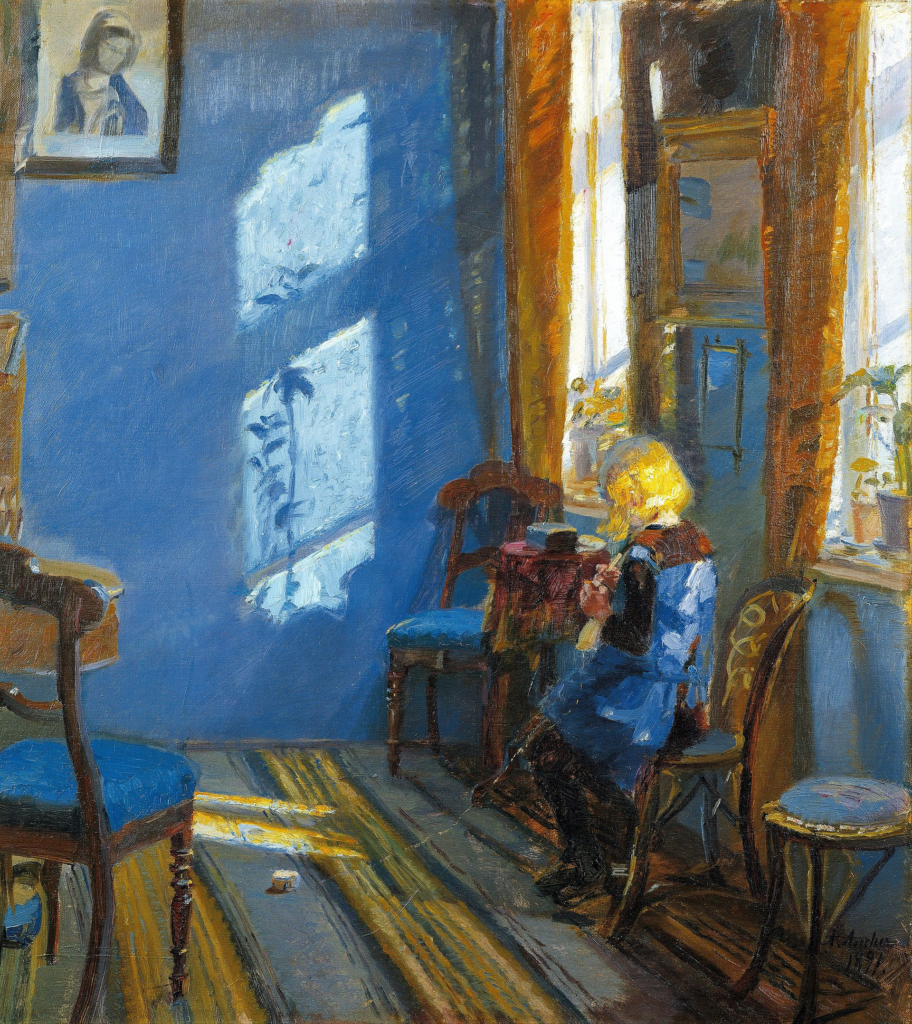
Anna Ancher’s “Sunlight in the Blue Room” (1891) is a masterful depiction of light and color, capturing a serene domestic interior bathed in warm sunlight. Ancher, a prominent member of the Skagen painters, is renowned for her ability to portray the interplay of natural light in everyday scenes. In this painting, she focuses on a quiet moment within a blue-painted room, where sunlight pours through a window, creating a striking contrast between the warm, golden light and the cool blue walls.
The composition highlights Ancher’s keen observational skills and her delicate handling of light and shadow. The sunlight casts intricate patterns on the walls and floor, illuminating the room with a sense of warmth and tranquility. The blue color of the room enhances the calm and reflective atmosphere, while the subtle details of furniture and décor contribute to the intimate, homely feel of the scene.
Large Still Life Interior (Blue) (1949) by Max Beckmann (German, 1884 – 1950)

Max Beckmann’s “Large Still Life Interior (Blue)” (1949) is a striking example of his post-war work, characterized by bold compositions and intense emotional content. This painting combines elements of still life and interior scenes, rendered in Beckmann’s distinctive, expressive style. The dominant blue hues create a moody and contemplative atmosphere, while the arrangement of objects and furniture in the interior suggests a complex narrative.
Beckmann’s use of color and form in this piece is both dramatic and symbolic. The blue tones convey a sense of melancholy and introspection, which is heightened by the stark contrasts and angular shapes that populate the scene. The objects within the room, such as the furniture, vases, and other household items, are depicted with a sense of solidity and weight, yet they also carry an air of mystery and tension.
The painting reflects Beckmann’s experiences and observations of the post-war era, infused with a personal sense of displacement and reflection. His approach to still life is unconventional, merging the genre with elements of psychological depth and narrative ambiguity. “Large Still Life Interior (Blue)” stands as a powerful testament to Beckmann’s ability to convey complex emotions and themes through his masterful use of color, composition, and symbolic content.
Blue Water Lilies (1916 – 1919) by Claude Monet (French, 1840-1926)

Claude Monet’s “Blue Water Lilies” (1916-1919) is a magnificent example of his iconic series of water lily paintings, which capture the serene beauty and ethereal qualities of his garden at Giverny. This painting focuses on the surface of a pond, filled with water lilies and reflections of the sky and surrounding foliage. Monet’s use of blue hues dominates the composition, creating a tranquil and immersive atmosphere.
In “Blue Water Lilies,” Monet employs loose, expressive brushstrokes to depict the water’s surface and the delicate lily pads floating on it. The interplay of light and color is masterfully rendered, with the blue tones suggesting the cool, reflective nature of the water. The painting’s abstract qualities, with its focus on color and light rather than detailed forms, exemplify Monet’s move towards a more impressionistic and almost abstract approach in his later years.
Fuel your creative fire & be a part of a supportive community that values how you love to live.
subscribe to our newsletter
*please check your Spam folder for the latest DesignDash Magazine issue immediately after subscription

Monet’s water lily series, including “Blue Water Lilies,” reflects his deep connection to nature and his relentless pursuit of capturing the ever-changing effects of light and color. This particular piece highlights the peaceful, almost meditative quality of his garden, inviting viewers to lose themselves in the soothing blues and the harmonious interplay of natural elements.
Blue Courtyard. Arenys de Munt by Santiago Rusiñol (Spanish, 1861 – 1931)
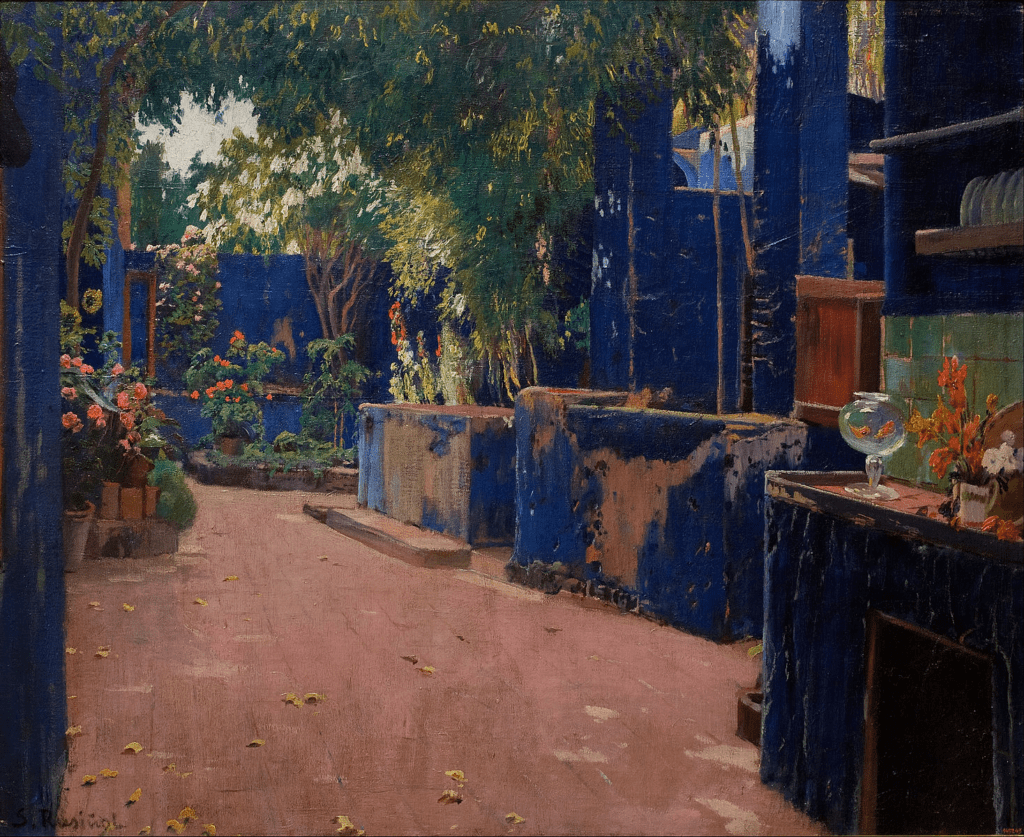
Santiago Rusiñol’s “Blue Courtyard, Arenys de Munt” is a captivating depiction of a tranquil outdoor space bathed in the cool tones of early morning or late afternoon light. Rusiñol, a key figure in the Modernisme movement in Catalonia, masterfully captures the serene ambiance of the courtyard, utilizing a palette dominated by various shades of blue.
The painting portrays a courtyard in the small town of Arenys de Munt, with its typical Mediterranean architecture and lush greenery. Rusiñol’s use of blue hues imparts a sense of calm and introspection, inviting viewers to appreciate the quiet beauty of the scene. The interplay of light and shadow is carefully rendered, highlighting the textures of the stone walls, tiled floors, and potted plants.
Seated Woman in Blue by Paul Cézanne (French, 1839-1906)

Paul Cézanne’s “Seated Woman in Blue” (c. 1900) is a remarkable example of his post-impressionist style, showcasing his innovative approach to form, color, and composition. This painting depicts a woman seated in a contemplative pose, dressed in a blue garment that dominates the composition. Cézanne’s use of blue in the woman’s attire adds a serene and calming effect to the overall scene.
Cézanne’s technique is evident in the way he constructs the figure using geometric shapes and bold brushstrokes, breaking down the form into its basic elements while still maintaining a sense of realism. The play of light and shadow on the blue dress and the surrounding space reveals his masterful understanding of color theory and his ability to convey depth and volume.
The composition is both simple and complex, with the seated woman becoming a central, almost monumental figure within the frame. The background is treated with equal importance, as Cézanne’s brushstrokes and color choices create a harmonious balance between the subject and her surroundings. The painting captures an introspective moment, highlighting Cézanne’s focus on the inner life and character of his subjects.
Little Girl in a Blue Armchair (1878) by Mary Cassatt (American, 1844-1926)
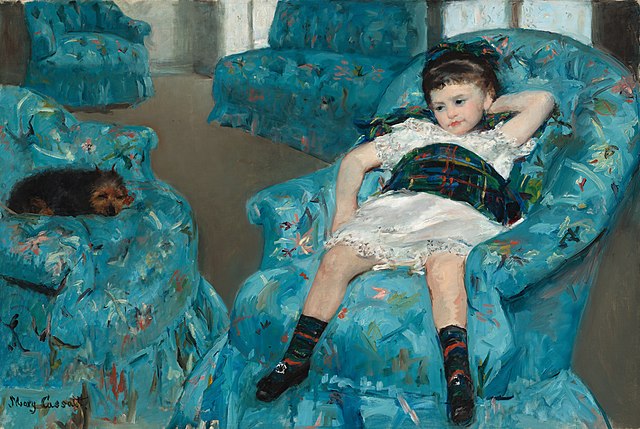
Mary Cassatt’s “Little Girl in a Blue Armchair” (1878) is a delightful and intimate portrayal of childhood, showcasing her keen observation and sensitivity to domestic scenes. The painting features a young girl lounging casually in a large, plush blue armchair, exuding a sense of ease and naturalness that contrasts with the more formal portraits typical of the era.
Cassatt’s use of color is masterful, with the rich blue of the armchair serving as a vibrant backdrop that highlights the girl’s relaxed posture and the softness of her dress. The interplay of blue and other hues in the room creates a harmonious and inviting atmosphere. The texture of the chair, depicted with loose, expressive brushstrokes, adds depth and dimension to the scene.
The composition is notable for its unconventional approach. Instead of positioning the girl in a stiff, posed manner, Cassatt captures her in a candid moment of rest, her body sprawled comfortably across the chair. This informal depiction reflects Cassatt’s interest in capturing the authenticity of everyday life and her ability to convey the individuality and inner world of her subjects.
“Little Girl in a Blue Armchair” also showcases Cassatt’s influence from her close association with the Impressionist movement, particularly her friendship with Edgar Degas. The painting’s emphasis on light, color, and everyday subject matter aligns with the Impressionist ethos while retaining Cassatt’s unique perspective on domestic interiors and the experiences of women and children.
Blue Horse I (1911) by Franz Marc (German, 1880-1916)
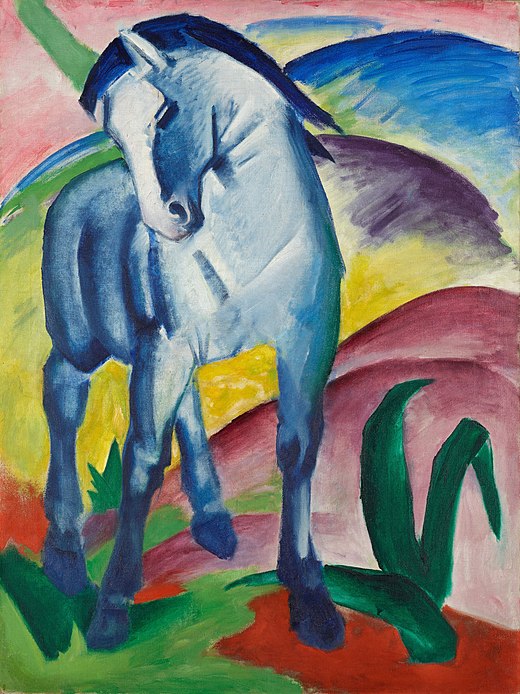
Franz Marc’s “Blue Horse I” (1911) is a striking and iconic example of his distinctive approach to color and form, emblematic of his contribution to the German Expressionist movement and the Blaue Reiter group, which he co-founded with Wassily Kandinsky. The painting features a vivid blue horse set against a contrasting background of greens, reds, and yellows, creating a powerful visual impact.
Marc’s choice of a blue horse is deeply symbolic. For Marc, animals represented a purer, more spiritual form of life, and he often used color to convey emotional and symbolic meanings. The blue horse in this painting embodies a sense of tranquility, spirituality, and harmony with nature. The use of blue also suggests a dreamlike, otherworldly quality, elevating the horse beyond a mere animal to a symbol of deeper significance.
The composition of “Blue Horse I” is both dynamic and harmonious. The horse is depicted in a stylized manner, with sweeping, curvilinear forms that convey a sense of movement and grace. Marc’s bold use of color and abstract forms breaks away from traditional representation, aligning with the Expressionist aim of expressing inner feelings and ideas rather than replicating reality.
Blue Night (1937) by Paul Klee (German, 1879 – 1940)
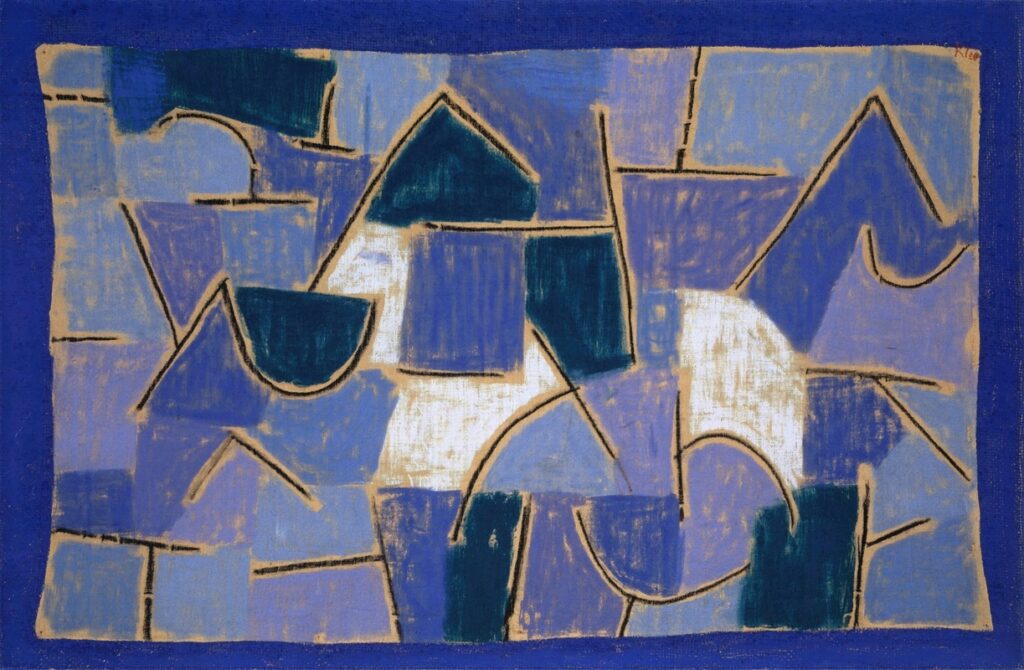
Paul Klee’s “Blue Night” (1937) is a captivating work that exemplifies his unique approach to abstract art, characterized by a deep exploration of color, form, and symbolism. The painting features a rich palette dominated by various shades of blue, creating a serene and contemplative nighttime scene. Klee’s intricate use of geometric shapes and patterns imbues the piece with a sense of harmony and mystery.
In “Blue Night,” Klee employs a grid-like composition, a common technique in his later works, to structure the abstract forms and guide the viewer’s eye across the canvas. The interplay of dark and light blues, interspersed with subtle touches of other colors, evokes the quiet, introspective atmosphere of night. The meticulous arrangement of shapes and lines creates a rhythmic, almost musical quality, reflecting Klee’s belief in the deep connection between visual art and music.
Mushrooms on a Blue Background (1929) by Marsden Hartley (American, 1877-1943)
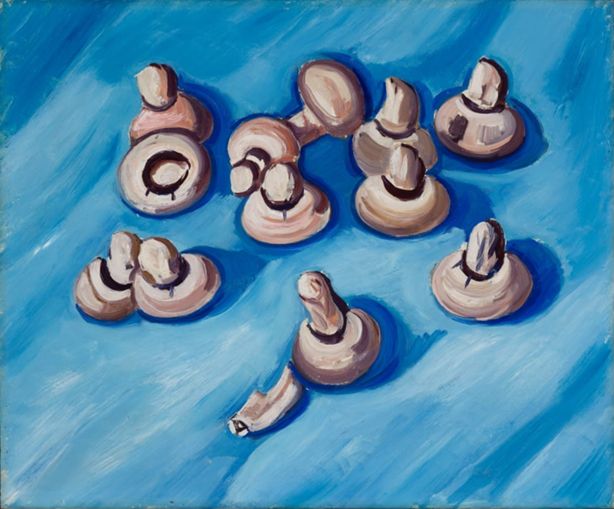
Now housed within the Robert and Traude Hensel Collection at the Indianapolis Museum of Art, this painting is one of Hartley’s later works. Marsden Hartley (1877-1943) was an influential American Modernist painter, poet, and essayist, known for his bold use of color, form, and symbolism. Born in Lewiston, Maine, Hartley studied art in Cleveland and New York, where he became associated with avant-garde circles and Alfred Stieglitz (a pioneer of photography). His work is characterized by a deep emotional intensity and often reflects his personal experiences and spiritual quests.
Hartley traveled extensively, drawing inspiration from European modernism, particularly German Expressionism, and later works showcased a return to American subjects with a focus on the rugged landscapes of his native Maine. His paintings frequently explore themes of identity, nature, and spirituality, making him a pivotal figure in the development of early 20th-century American art.
Red + Violet with 2 Grays + 2 Blues (1948) by Josef Albers (German-American, 1888 – 1976)
Josef Albers’ “Red + Violet with 2 Grays + 2 Blues” (1948) is a striking example of his exploration of color theory and abstract composition. Albers, a pivotal figure in both the Bauhaus movement in Germany and later at Black Mountain College and Yale University in the United States, is renowned for his precise geometric abstractions and his studies on the interaction of colors.
In “Red + Violet with 2 Grays + 2 Blues,” Albers uses a limited but bold color palette to create a composition that explores the relationships and contrasts between different hues. The painting features interlocking rectangles and squares, each meticulously painted to test the visual perception of color interactions. The juxtaposition of red and violet with varying shades of gray and blue creates a dynamic visual effect, where colors seem to vibrate and shift depending on their context and surrounding colors.
While this painting is currently under copyright, we have included four similar paintings from Josef Albers’s Variant/Adobe series above.
The Starry Night (1889) by Vincent van Gogh (Dutch, 1853-1890)

Vincent van Gogh’s “The Starry Night” (1889) is one of the most famous and iconic paintings in the history of Western art. Created during his stay at the Saint-Paul-de-Mausole asylum in Saint-Rémy-de-Provence, France, the painting captures a swirling night sky over a quiet village, with a prominent cypress tree in the foreground. Van Gogh’s use of bold, expressive brushstrokes and vivid colors conveys a sense of movement and emotion, transforming the night sky into a dynamic and almost mystical scene.
The swirling patterns of the stars and clouds, along with the bright crescent moon, create a dreamlike and otherworldly atmosphere. The contrast between the turbulent sky and the calm, sleeping village below reflects van Gogh’s inner turmoil and longing for peace. The cypress tree, often associated with death and eternal life, reaches upwards, connecting the earth with the sky, symbolizing a bridge between the mortal and the eternal.
“The Starry Night” is a quintessential example of van Gogh’s ability to convey his emotional and psychological state through his art. Despite his struggles with mental health, which are poignantly reflected in the painting, van Gogh’s work is celebrated for its innovative use of color and form, as well as its profound emotional depth. Today, “The Starry Night” is housed in the Museum of Modern Art in New York City, where it continues to inspire and captivate audiences from around the world.
Abstraction Blue (1927) by Georgia O’Keeffe (American, 1887-1986)
Georgia O’Keeffe’s “Abstraction Blue” (1927) is a striking example of her innovative approach to abstraction and color. Known for her unique ability to distill natural forms into their essential shapes and hues, O’Keeffe captures the viewer’s imagination with this piece, which departs from representational art styles to explore the emotional and symbolic potential of color and form.
In “Abstraction Blue,” O’Keeffe employs a palette dominated by rich blues, creating a sense of depth and fluidity. The painting features undulating, organic shapes that evoke the natural world while remaining abstract. The flowing forms and gradations of blue suggest a sense of movement and tranquility, reminiscent of water or the sky. This work exemplifies O’Keeffe’s skill in using color to convey mood and atmosphere, as well as her interest in the interplay between abstraction and nature.
The composition’s bold simplicity and the sensual curves of the shapes reflect O’Keeffe’s desire to capture the essence of her subjects rather than their literal appearances. “Abstraction Blue” stands as a testament to her mastery of color and form, and her ability to evoke powerful emotions through minimalist, abstract designs.
O’Keeffe’s work, including “Abstraction Blue,” has had a lasting impact on American modernism, and she is celebrated as one of the foremost artists of the 20th century. Her contributions to abstract art, alongside her iconic representations of flowers, landscapes, and bones, have solidified her legacy as a pioneering and influential figure in the art world.
Blue Monochrome (1961) by Yves Klein (French, 1928-1962)
Yves Klein’s monochromatic blue paintings are celebrated for their profound visual impact and their exploration of pure color as an artistic medium. By using dry pigment suspended in a synthetic polymer, Klein was able to achieve a highly saturated, luminous blue that appears to almost glow from within. The use of this particular medium allowed the pigment to retain its intense coloration without losing its matte finish, creating a velvety, absorbing surface that draws the viewer in.
The dimensions of 6′ 5″ x 4′ 7″ give this painting in MoMA’s collection a commanding presence, inviting viewers to experience the color field in a way that is both immersive and contemplative. Klein’s work in this period focused on the concept of the void and the infinite, using his signature blue to evoke a sense of boundless space and spiritual depth.
The Blue Boy (c. 1770) by Thomas Gainsborough (English, 1727-1788)

Thomas Gainsborough’s “The Blue Boy” (c. 1770) is one of the most famous and celebrated works of 18th-century portraiture. This full-length portrait features a young boy dressed in an opulent blue satin outfit, standing confidently against a landscape background. The identity of the boy has been traditionally believed to be Jonathan Buttall, the son of a wealthy merchant, although this has not been definitively confirmed.
Gainsborough’s use of this blue shade in the painting is particularly striking and innovative for the time. The rich, luminous blue satin suit contrasts dramatically with the muted tones of the background, drawing immediate attention to the figure of the boy. Gainsborough’s mastery of texture is evident in the detailed rendering of the fabric, which shimmers and folds realistically, showcasing his skill in capturing the material qualities of clothing. The composition of “The Blue Boy” is notable for its elegance and balance. The boy’s confident stance, with one hand on his hip and the other holding a plumed hat, exudes a sense of poise and sophistication. The background, featuring a natural landscape with soft, diffuse lighting, complements the figure without detracting from the central focus.
“The Blue Boy” is often interpreted as a response to the works of Sir Anthony van Dyck, the Flemish Baroque artist whose portraits of English aristocracy greatly influenced Gainsborough. The painting’s style and execution reflect Gainsborough’s admiration for van Dyck, while also demonstrating his own unique approach to portraiture. Today, “The Blue Boy” is housed in The Huntington Library, Art Museum, and Botanical Gardens in San Marino, California and has been part of many an incredible exhibition. It remains an iconic example of Gainsborough’s artistry and a testament to his enduring legacy in the history of British art.
Blue Nude II (1952) by Henri Matisse (French, 1869-1954)
Henri Matisse’s “Blue Nude II” (1952) is a remarkable work from his late period, specifically from his series of paper cut-outs. Created when Matisse’s health no longer allowed him to paint in the traditional manner, these cut-outs became a vital part of his creative output and are celebrated for their bold simplicity and expressive power.
“Blue Nude II” features a stylized, abstracted female form created through the technique of cut paper. Matisse first painted sheets of paper with a vibrant blue gouache and then cut them into various shapes, which he arranged and pasted onto a white background. The resulting figure is both simplified and dynamic, characterized by fluid lines and organic shapes that convey a sense of movement and grace. The blue color in “Blue Nude II” is significant, as Matisse used it to evoke emotional depth and tranquility. The work reflects Matisse’s ability to distill forms to their essence, capturing the beauty and vitality of the human figure with minimal detail.
The “Blue Nudes” series, to which “Blue Nude II” belongs, is one of Matisse’s most iconic contributions to modern art. These works are celebrated for their innovation and the way they push the boundaries of traditional artistic techniques. They demonstrate Matisse’s lifelong dedication to exploring color and form, even as he adapted his methods to his physical limitations.
Le Soup (1902-1903) by Pablo Picasso (Spanish, 1881-1973)

“Le Soupe” (The Soup) is a significant work by Pablo Picasso, created during his Blue Period, a time when his paintings were characterized by somber tones and melancholic themes. “Le Soupe” depicts a poignant scene of charity and compassion. The painting shows a young girl receiving a bowl of soup from an older woman, possibly her mother or a caregiver. The figures are rendered in shades of blue and gray, typical of Picasso’s Blue Period, which was marked by themes of poverty, despair, and human suffering.
The use of blue not only conveys the emotional weight of the scene but also unifies the composition, creating a sense of coldness and isolation. The figures are elongated and somewhat stylized, emphasizing their fragile, almost ghostly presence. The simplicity of the composition and the limited color palette draw attention to the emotional interaction between the two characters. The young girl’s tentative gesture and the woman’s gentle, yet firm, offering of the soup highlight themes of dependence and care. The painting reflects Picasso’s deep empathy for the marginalized and the downtrodden, influenced by his own experiences of poverty and hardship during his early years in Paris.
“Le Soupe” is a powerful example of Picasso’s ability to convey deep human emotions and social commentary through his art. It is celebrated for its emotional depth, simplicity, and the way it encapsulates the essence of Picasso’s Blue Period. The painting resides in the Art Gallery of Ontario in Toronto, Canada, where it continues to resonate with viewers and evoke empathy and reflection.
Are You Drawn to Blue as an Artist or Designer?
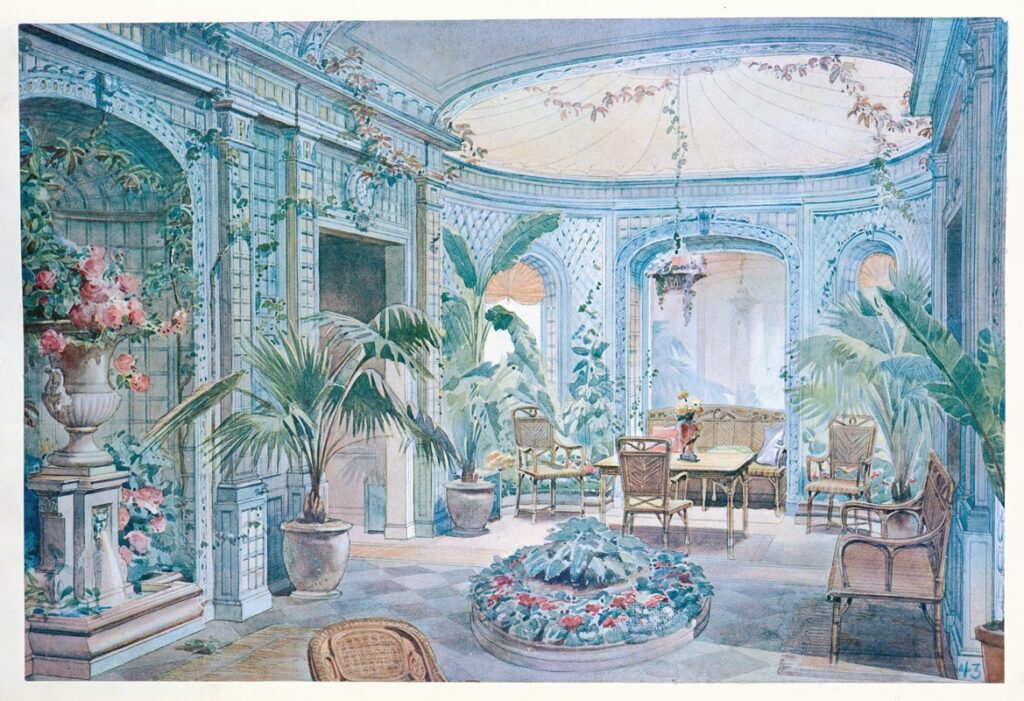
Are you drawn to blue as an artist or designer? This color, rich with symbolism and emotional depth, has been a powerful tool for countless artists throughout history, from the tranquil serenity of Monet’s water lilies to the spiritual and abstract forms of Yves Klein and Matisse. Whether evoking calm, introspection, or a sense of infinity, blue can transform a composition and stir profound responses in viewers. Reflect on how you might incorporate blue into your own creative work, and consider the myriad ways this versatile hue can enhance your artistic expression and connect with your audience on a deeper emotional level.








